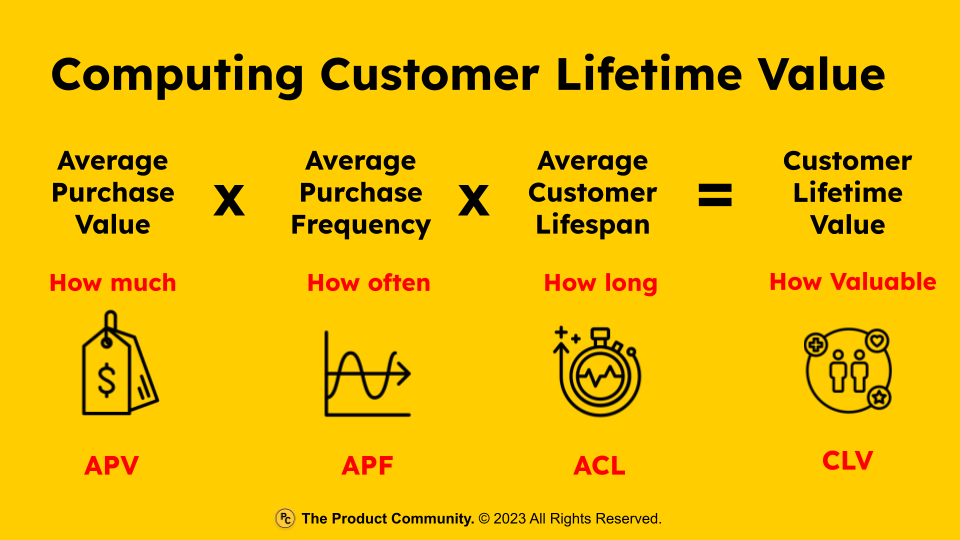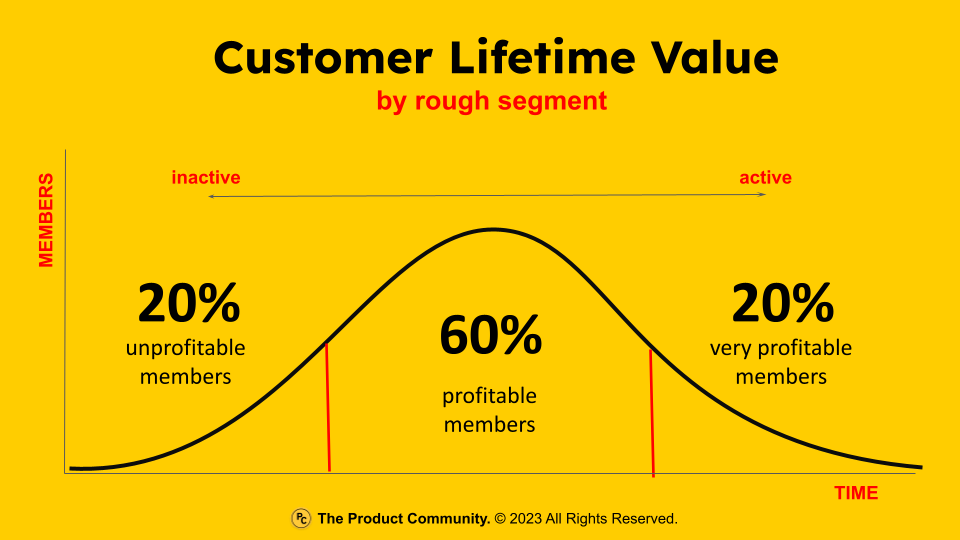Growing Revenue Over the Lifecycle
How to Calculate and Use Customer Lifetime Value to Grow Your Association.
Summary
I’m not a huge fan of membership goals.
But, I love helping associations position themselves for focused innovation, exciting new value, and ongoing, meaningful engagement. Why? Because it results in robust membership and diversified engagement.
Membership is always an outcome (not a goal).
The association of the future focuses on deeply understanding what makes our members tick by engaging in continuous discovery and building meaningful relationships over time. Only then, can we create, shape, and deliver the right products at the right time to ensure members come back for more and ensure they will tell their friends.
This is an article about a single important metric, called customer lifetime value. Master it, and you will help position your association for an unending connection of engaged members and healthy, diversified growth.
The Product Community is a product development learning community designed specifically for associations.
What is Customer Lifetime Value?
“Customer lifetime value encourages organizations to shift their focus from quarterly profits to the long-term health of their customer relationships.”
Paul W. Farris
Customer Lifetime Value (CLV), is a metric that quantifies the total revenue an association can expect to earn from a member throughout their entire relationship with the association. Here, the word customer refers to members who pay fees to access and utilize association benefits.
CLV is important for associations as it helps us understand the value of their members and their overall membership program. Here are some additional reasons by CLV is important:
Strategic Decision-Making: CLV can guide our resource allocation decisions. By knowing CLV, we can determine how much we’re willing to invest in acquiring and retaining members.
Member Segmentation: CLV allows us to segment membership based on value derived. This enables tailored marketing efforts and more personalized customer service and ensures we can identify high-value members (what I like to call multiplier members).
Retention Strategies: CLV highlights the importance of retaining members over the long term. Associations can focus on keeping high-CLV members satisfied, while cultivating mid-CLV members to engage more and buy more at an increased pace. Both can lead to increased margins.
Product Development: Understanding CLV can guide product development efforts by prioritizing ideas, features, and improvements that resonate with high-CLV or mid-CLV members.
CLV takes into account all fees paid by the member over the course of their membership. It includes both dues and non-dues revenue generated through events, publications, or other services. Though not covered specifically in this article, it is important to consider the likelihood of member renewal as well as the potential for members to refer others to the association.
To maximize CLV, associations should focus on providing exceptional value to their members through high-quality programming, peer engagement, and ongoing opportunities to help shape direction. By maintaining an engaged membership community, we can diversify revenue, drive growth, and achieve our vision.
How to Calculate Customer Lifetime Value
“Not all customers are equally important.”
Don Peppers and Martha Rogers
CLV can be calculated at an organization-wide level (i.e. the average CLV across your membership community), a customer segment level (the CLV of distinct groups within your member base) or an individual level (the CLV of each individual member you deal with).
Let’s illustrate an association-wide CLV. There are several methods to calculate CLV. This is one of the simplest:
Average Purchase Value (APV) – Calculate the average amount a member spends on each purchase. This is typically the total revenue divided by the number of purchases over a specified period.
Average Purchase Frequency (APF) – Determine how often members make purchases. This is the total number of purchases divided by the number of members over the same period.
Average Customer Lifespan (ACL) – Estimate the average number of years a member remains engaged with the association. This can be based on historical data or industry benchmarks.
Here is an example for an association for architects:
Average Purchase Value (APV) – On average, your members pay $500 in annual membership fees.
Average Purchase Frequency (APF) – Your members renew their memberships, on average, every 2 years. This means they make a purchase (renew their membership) once every 2 years. For ease of calculation, we’re not including non-dues revenue in the example.
Average Customer Lifespan (ACL) – The average architect remains a member of your association for about 10 years.
Now, plug these values into the CLV formula:
CLV = $500 (APV) x 0.5 (APF) x 10 (ACL) = $2,500
We will now review how to use CLV. A high CLV means each member will bring in more revenue for your association. As each member becomes more valuable, our association can invest more in the product development or value creation needed to acquire new members and retain (and increase the engagement of) existing ones.
How to Use Your CLV Calculations
“Be realistic about the present while maximizing potential for the future”
Melanie Whelan
Once you know your CLV – whether it’s an average or organized by segment – there are plenty of ways to to track your member experience investments and to identify new opportunities to design experiences that contribute to the bottom line.
Here is a simple, non-scientific way of looking at CLV by the rough segments of unprofitable, profitable, and very profitable. Though I’ve yet to run specific numbers, I will assume that the very profitable members (the ones who spend the most money on the most things, most often, over time) are also the most active and most engaged.
This makes them important for several reasons:
They are loyal, engaged, and spend money to stay connected.
They serve as a model to help us identify, cultivate, and evolve profitable members (the 60% reflected in the bell curve above to becoming very profitable members.
They are probably influencers (or multipliers) who can play a connector, maven, or salesperson role (who can – and often will! – tell their friends).
Here are some of the ways you can use CLV:
Optimize your marketing spend — By knowing which members are most valuable, we can prioritize our member acquisition strategies, making sure we allocate resources in the areas that will attract the right members.
Create an engagement funnel — One way of replicating the very profitable members is to learn how to replicate and grow them. We can do this by creating an engagement funnel that identifies, attracts, and grows people who will engage deeply.
Reduce churn and drive loyalty — Member-facing teams can use CLV data to inform decisions about which members to target when preventing churn. We can use CLV to identify members to nurture before they cancel.
Identify costly touchpoints — CLV data can help identify low-impact touchpoints. With this insight, we can determine the root cause and take action to close the gap.
Develop new products — CLV can also help identify the breakthrough touchpoints that have a positive impact. We can then dig deeper to identify why so we can consider using other channels, identifying new segments, or building new products that drive even greater increases in CLV.
In the end, like with most strategy tools, CLV should be used with other tools, practices, and data to ensure we’re aware of (and can track) important patterns of engagement.
Marathon not Sprint
“There is no virtue in clinging to tradition merely for its own sake.”
Kazuo Ishiguro
Identifying and cultivating very profitable members can have a compounding effect. They are most likely the most influential, most visible, and most engaged. Over time, this can have a powerful multiplier effect on your community.
Cultivating these multipliers takes good data, sound strategy, and space to collaborate across units (membership, learning, technology, etc.). It also means we need parallel strategies to simultaneously engage and grow the profitable members, the unprofitable members, and to identify and bring on board prospective members
In the product community, we believe in four things:
Cultivating deep connections and strong relationships with members.
Developing the right value – products, experiences, programming – at the right time to spark engagement and solve member problems.
Positioning robust membership and diversified revenue as success outcomes and indicators of health (not short-term goals).
Designing membership as a longitudinal, perennial connection in which one pays money willingly to be part of an exciting value proposition (in which we’re moving the needle on high-impact problems).
Computing (and using) customer lifetime value is one way to leverage your data to ensure these things come true.
Remember, product-led growth fuels connection. Join the product community and flip your destiny.
About the Author
James Young is founder and chief learning officer of the product community®. Jim is an engaging trainer and leading thinker in the worlds of associations, learning communities, and product development. Prior to starting the product community®, Jim served as Chief Learning Officer at both the American College of Chest Physicians and the Society of College and University Planning.
Please contact me for a conversation: james@productcommunity.us.






